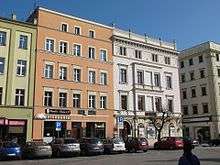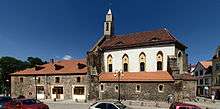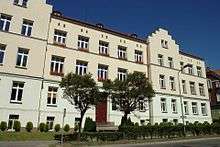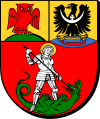Dzierżoniów
| Dzierżoniów | |||
|---|---|---|---|
|
Town Hall | |||
| |||
 Dzierżoniów | |||
| Coordinates: 50°43′41″N 16°39′04″E / 50.72806°N 16.65111°E | |||
| Country |
| ||
| Voivodeship | Lower Silesian | ||
| County | Dzierżoniów County | ||
| Gmina | Dzierżoniów (urban gmina) | ||
| Established | 13th century | ||
| Town rights | before 1290 | ||
| Government | |||
| • Mayor | Dariusz Kucharski | ||
| Area | |||
| • Total | 20.07 km2 (7.75 sq mi) | ||
| Elevation | 261 m (856 ft) | ||
| Population (2008) | |||
| • Total | 34,396 | ||
| • Density | 1,700/km2 (4,400/sq mi) | ||
| Time zone | CET (UTC+1) | ||
| • Summer (DST) | CEST (UTC+2) | ||
| Postal code | 58-200 to 58-205 | ||
| Area code(s) | +48 74 | ||
| Car plates | DDZ | ||
| Website | Dzierżoniów.pl | ||
Dzierżoniów [d͡ʑerˈʐɔɲuf] (German: Reichenbach [ˈʁaɪ̯çn̩bax]; from 1945-1946 Polish: Rychbach, Drobniszew)[1] is a town located at the foot of the Owl Mountains in southwestern Poland, within the Lower Silesian Voivodeship (from 1975–1998 in the former Wałbrzych Voivodeship). It is the seat of Dzierżoniów County, and of Gmina Dzierżoniów (although it is not part of the territory of the latter, since the town forms a separate urban gmina).
Established in the 13th century, Dzierżoniów is a historical Lower Silesian town that covers an area of 20.1 square kilometres (7.8 sq mi), and according to official figures for 2008 has a population of 34,396. It is named after Polish priest and scientist Jan Dzierżon.[2]
Unique and architecturally rich, Dzierżoniów features a central market square with elegant tenements and a town hall as well as few museums and restaurants. The Old Town is a venue for several annual events and fairs.[3]
History

In its early history, the town was known as Reichenbach; composed of the German words reich (rich, strong) and Bach (stream), it refers to the current of the Piława River.[4] The name was rendered in Polish as Rychbach. To differentiate between other places named Reichenbach, the Lower Silesian town became known in German as Reichenbach im Eulengebirge, or "Reichenbach in the Owl Mountains".
Reichenbach was first mentioned in a document dating to 13 February 1258.[5] The parish Church of St. George was also noted early on.[6] The coat of arms, depicting Saint George slaying a dragon, was used by 1290 at the latest. The town passed successively from the Bishopric of Wrocław (Breslau), to the Duchy of Ziębice (Münsterberg), and to the Duchy of Świdnica-Jawor (Schweidnitz-Jauer).[5] Reichenbach became part of the Kingdom of Bohemia in 1325 and the Knights Hospitaller built a school and hospital in the town in 1338. It was plundered by the Hussites during the 15th-century Hussite Wars.[5]
The Habsburg Monarchy of Austria inherited the Bohemian throne in 1526 and became the town's new lords. Reichenbach developed into a trading center, especially for textiles and linen, during the 16th century.[7] After the First Silesian War in 1742, most of Silesia, including Reichenbach, became part of the Kingdom of Prussia. In 1762 during the Seven Years' War, the region between Reichenbach and Schweidnitz (Świdnica) was the setting for the Battle of Burkersdorf between Prussia and Austria.

In 1790 representatives from Austria, Prussia, the Dutch Republic, and Poland met at Reichenbach to discuss the Ottoman wars in Europe. In 1813 Tsar Alexander I of Russia met with King Frederick William III of Prussia. From 1816–1945 Reichenbach contained the district office for Landkreis Reichenbach (Reichenbach district). Until 1820 the town was the seat of a Prussian district president. Reichenbach was connected to a rail network in 1855. It became part of the Prussian-led German Empire in 1871. It was occupied by the Red Army on 8 May 1945.
Reichenbach was transferred from Germany to Poland in 1945 after World War II. Many of its German inhabitants had fled earlier in 1945 before the war's end, while most of those who had stayed were subsequently expelled. The void was filled by Poles moving in, some of whom from the eastern part of the country that had been annexed by the Soviet Union.
In the period immediately following World War II, the town was known by different names. The municipal office, the local office and the railway administration all used different names for it: Rychbach (its traditional Polish name), Reichenbach and Drobniszew.[8] In 1946 the town was renamed Dzierżoniów after the apiarist Jan Dzierżon; ironically, Germany also viewed Dzierżon as one of their own, and in 1936, as part of a Nazi effort to remove Slavic-sounding place names, his birthplace, Lowkowitz (now Łowkowice), was renamed Bienendorf ("Bee village") in his honor.

During World War II there was a large concentration camp in Lower Silesia, Gross-Rosen, with important branches in Dzierżoniów and in two additional nearby towns. There were about 20,000 Jewish survivors of the camp, many of whom were Polish Jews. They did not want to go back to their hometowns because of the decimation of their Jewish communities and the fear of antisemitic violence. They were later joined by Polish Jews repatriated from the Soviet Union, and others who had survived in hiding in Poland or returned from concentration camps in Germany.[9]
Thus, the peak number of Jews in Drobniszew was 17,800 reached in November 1946[10] of the 50,000-Jew commune in Dzierżoniów County (incl. Bielawa, Pieszyce, Piława Górna, etc.) led by Jakub Egit from 1945-1948.[11]
One of the town's synagogues survived the war and has been restored.[12][13]
Notable residents
- Herbert Giersch (1921–2010), German economist
Town twinning
Dzierżoniów is twinned with five cities:[14]
 Bischofheim, Germany (since 1990)
Bischofheim, Germany (since 1990)  Lanškroun, Czech Republic (since 1999)
Lanškroun, Czech Republic (since 1999) Crewe, United Kingdom (since 2005)
Crewe, United Kingdom (since 2005) Serock, Poland
Serock, Poland Kluczbork, Poland
Kluczbork, Poland
References
- ↑ Jun, Yoshioka (March 2007), "Chapter 14, Imagining Their Lands as Ours: Place Name Changes on Ex—German Territories in Poland after World War II" (PDF), Part 4, Regional Identities in Central and Eastern Europe, Slavic Eurasian Studies, No.15, Regions in Central and Eastern Europe: Past and Present, pp. 273-287, Sapporo, Japan: Slavic-Eurasian Research Center, p. 279, ISBN 978-4-938637-43-9
- ↑ o.o., StayPoland Sp. z. "Dzierzoniow". www.staypoland.com. Retrieved 20 June 2017.
- ↑ "Tourism - Dzierżoniów". www.dzierzoniow.pl. Retrieved 20 June 2017.
- ↑ Adrian Room. Placenames of the World. McFarland & Company, 2005. ISBN 0-7864-2248-3
- 1 2 3 Um.Dzierzonow.pl. "History". Accessed December 7, 2006.
- ↑ Urlaub-Polen.de "Dzierzoniów / Reichenbach". Accessed December 7, 2006. (in German)
- ↑ Um.Dzierzonow.pl. "Geschichte". Accessed December 7, 2006. (in German)
- ↑ http://src-h.slav.hokudai.ac.jp/coe21/publish/no15_ses/14_yoshioka.pdf
- ↑ ""A Place Where Polish-Jewish Relations Could Start Anew": Interview with Kamil Kijek". Retrieved 20 June 2017.
- ↑ "History - Jewish community before 1989 - Dzierżoniów - Virtual Shtetl". www.sztetl.org.pl. Retrieved 20 June 2017.
- ↑ Bożena Szaynok, "Żydowscy żołnierze z Bolkowa", Odra 1999, 9, p. 22-26, in Polish
- ↑ "The Dzierżoniów - Reinchenbach Synagogue Rescue Project - Beiteinu Chaj - 2004 Foundation". Retrieved 20 June 2017.
- ↑ Gruber, Samuel (20 September 2009). "Samuel Gruber's Jewish Art & Monuments: Poland: Dzierżoniów Synagogue Reopens for Rosh Hoshanah". Retrieved 20 June 2017.
- ↑ "Twin towns". dzierzoniow.pl. Retrieved 26 April 2014.
External links
- Municipal website
- Jewish Community in Dzierżoniów on Virtual Shtetl
| Wikimedia Commons has media related to Dzierżoniów. |
Coordinates: 50°43′41″N 16°39′4″E / 50.72806°N 16.65111°E


